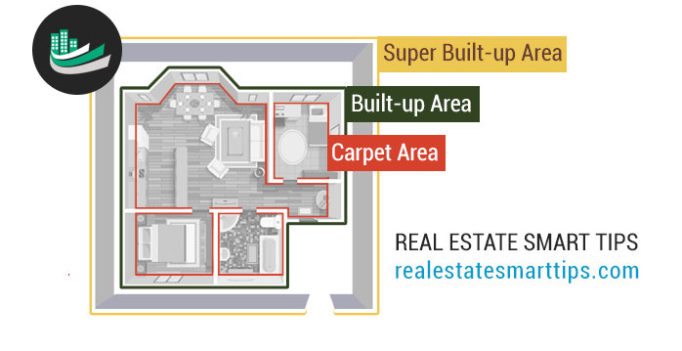Planning to buy a flat or a commercial property? As you approach the real estate agent you will get to hear terms such as carpet area, built-up area & super built-up area. Now, it becomes exceedingly important for you to know and understand the difference between all these ‘areas’. Most importantly, you need to realise what they mean for you financially? How they affect your lifestyle? However, it affects your lifestyle only if you propose to buy a residential property.
Carpet Area, Built-up Area & Super Built-up Area
1. What is the Carpet Area?
To put in simple words it is the net usable area. Hence, this is the space finally available to the buyer. Most importantly, it does not include the thickness of pillars and inner walls. This is calculated from the inner side of one wall to another. The common areas like lifts, staircase, lobby, play area too not included. Consequently, this is the actual area a buyer enjoys for purpose of living. Let’s say, the bedroom, living room, dining area, kitchen, balcony, toilet, etc.
2. What is Built-up Area?
The built-up area (BU) consists of carpet area plus the area covered by the inner and outer walls of the property along with areas of flower beds, dry balcony, etc. BU is the aggregate area that the property covers. Wondering how to calculate built-up area? Let’s explain.
3. Carpet Area a Part of Built-up Area
Logically, built-up area = carpet area + areas covered by walls. Usually, it is 10-15 per cent more than the carpet area. Hence, if built up area is 1,000 sq ft, it means 30 per cent i.e. the 300 sq ft is out of use while 700 sq ft is the left over area that you can actually use.
4. What is Super Built-up Area (SBU)?
The super built-up area (SBU) consists of the proportionate area of common spaces of a building. To mention a few; lobby, staircase, passages, elevator, community hall, park (if any) etc. The SBU is the proportionate share of land that a buyer needs to pay for.
5. Calculating super built-up area
Well, super built-up areas include common areas such as elevator, corridor, clubhouse, etc. Basically, developers consider 1.25 as a multiplying factor to compute super built-up area. Subsequently, this increases the total marketable area by 25 per cent. This percentage is referred to as loading.
6. Concept of Built-up and Super Built-up
It is important to note that Built-up and Super Built-up have no legal sanction. Consequently, no developer mentions it in the agreement for sale of the property. Thus, it is only the carpet area of the property that has a legal sanction. Hence, that is only mentioned in the agreement for sale.
Built-up and Super Built-up areas are just strategies of the developers. Furthermore, the developers plan these to make an impression on the buyer in three ways. First, the buyer gets the feeling that he is buying a larger property for the same price. Second, he at times feels that the builder is selling a property of equivalent size at a lower rate. Lastly, the developer charges more for a property by counting areas of walls (in the case of BU) and in proportion of common spaces (in the case of SBU) in the marketable area of the property.
To Conclude
If you are looking to evaluate the cost and the area of the flat, the assessment should be based on carpet area and not built-up or super built up.
For a comprehensive explanation Click.
Please “Like” & Share to enlighten others.
Looking for more information on real estate? Keep exploring.


Be the first to comment